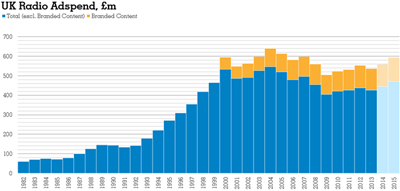After recording a dip in advertising spend in 2013, radio has started the year positively, according to the latest data from the Advertising Association/Warc Expenditure Report.
Traditional radio adspend (excluding branded content) totalled £426m in 2013, marking a 2.9% fall year-on-year and some £120m less than its peak nine years ago. In real terms (after accounting for inflation) the 2013 total was £337m, and representative of a 5.3% annual decline at 2005 prices.
But this looks set to change in 2014. Data show that radio adspend has started this year strongly, rising by 5.7% in Q1 compared with last year to £113m. This rate of growth is greater than the all-media total of 5% for Q1, suggesting things are looking up for the sector.
Moreover, radio adspend is expected to record a strong Q2 (+7.6% annually), aided by the World Cup, although the rate of growth will ease over the rest of the year. Despite a slower second half, we expect radio to register annual growth of 4.4% in 2014, the medium's best performance since 2003 when spend rose 6.8%.

(Click image to enlarge)
Source: AA/Warc Expenditure Report.
This trend will continue over the forecast period, and we believe an annual rise of 6% in 2015 will put UK radio adspend at over £470m (£360m in real terms).
Another element of radio advertising spend is branded content - output funded either in part or wholly by a brand rather than the broadcaster - which added a further £111m to the traditional airtime format in 2013.
Changes to the Broadcasting Code in late 2010 allowed for greater integration of commercial communications within radio programming. The most notable freedom granted by the amendments is that presenters can now make endorsements live on air, provided it is made clear to listeners that a commercial arrangement is in place.
Last year marked the first annual fall (-2.8%) for a form of advertising that has grown in spend by 52% over the last decade. But, despite the contraction in 2013 spend, branded content is predicted to continue to grow, accounting for some £122m of expenditure in 2015, the highest level recorded to date.
There is some consensus that branded content via the radio is appealing to many planners due to its less regimented feel, while recent research by the Radio Advertising Bureau (RAB) found that the medium now delivers an average return of £7.70 for every pound spent on advertising.
Mark Barber, Planning Director at the RAB, said "With audience reach continuing to hit near record levels, radio remains in robust health offering advertisers a proven brand and business driving opportunity at scale. 2013 represented just a small blip on an otherwise consistent upward radio revenue trend since the recession of 2009.
The impressive H1 2014 airtime performance suggests that advertiser confidence in the medium has been boosted further by the unequivocal findings from RAB's ROI Multiplier analysis which demonstrated the untapped revenue-driving potential of radio. With radio branded content regulation meaning that it is ideally placed to fulfil the concept of 'native advertising' we also expect to see a strong return to growth for this format over H2 2014."
The Expenditure Report also allows users to analyse radio adspend at a regional level. Within the 2013 adspend total, national radio (i.e. advertising booked through agencies inside the M25 belt) accounted for some £266m, representative of a steep annual decline (-9.1%) compared with 2012. The remaining £160m can be accredited to local spend (agencies outside the M25), which rose 4.3% year-on-year in 2013. While national adspend currently accounts for the majority share, local adspend is at its highest ever share on 37.5%, following a third consecutive year-on-year rise.
To find out more about subscribing to the AA/Warc Expenditure Report, please visit the website or contact Suzy Young for additional information.

